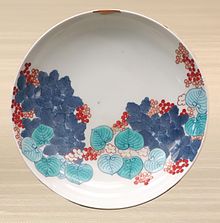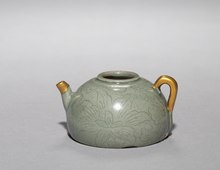what kind of gold do use use to fill cracks in pottery

Repair piece of work (correct) on Mishima ware hakeme -type tea bowl with kintsugi gold lacquer, 16th century

Kintsugi ( 金継ぎ , "aureate joinery"), too known as kintsukuroi ( 金繕い , "golden repair"),[1] is the Japanese art of repairing broken pottery by mending the areas of breakage with lacquer dusted or mixed with powdered gilded, silver, or platinum; the method is like to the maki-east technique.[2] [3] [4] As a philosophy, information technology treats breakage and repair as part of the history of an object, rather than something to disguise.[five]
Origin [edit]
Lacquerware is a longstanding tradition in Japan[6] [seven] and, at some indicate, kintsugi may accept been combined with maki-e every bit a replacement for other ceramic repair techniques. While the process is associated with Japanese craftsmen, the technique was too applied to ceramic pieces of other origins including China, Vietnam, and Korea.[8]
Kintsugi became closely associated with ceramic vessels used for chanoyu (Japanese tea ceremony).[3] I theory is that kintsugi may have originated when Japanese shōgun Ashikaga Yoshimasa sent a damaged Chinese tea basin dorsum to China for repairs in the late 15th century. When information technology was returned, repaired with ugly metal staples, it may have prompted Japanese craftsmen to look for a more aesthetically pleasing means of repair.[9] Collectors became so enamored of the new art that some were accused of deliberately groovy valuable pottery so it could exist repaired with the gold seams of kintsugi . [2] Information technology is also possible that a pottery piece was chosen for deformities it had acquired during product, and so deliberately broken and repaired, instead of being trashed. [two] On the other paw, co-ordinate to Bakōhan Saōki (record of tea-bowl with a 'large-locust' clench), such "ugliness" was considered inspirational and Zen-like, equally it connoted beauty in broken things. The bowl became valued fifty-fifty more highly because of these large metal staples, which looked like a locust, and the bowl was named 'bakōhan ("large-locust clamp").[10]
Philosophy [edit]

Goryeo wine ewer with gilded lacquer repair. Information technology was repaired by a Japanese collector in the early 20th century.
Equally a philosophy, kintsugi is like to the Japanese philosophy of wabi-sabi , an embracing of the flawed or imperfect.[11] [12] Japanese aesthetics values marks of vesture from the utilise of an object. This can be seen every bit a rationale for keeping an object around even subsequently it has broken; it tin also be understood as a justification of kintsugi itself, highlighting cracks and repairs equally events in the life of an object, rather than assuasive its service to finish at the time of its damage or breakage. The philosophy of kintsugi tin can also be seen as a variant of the aphorism, "Waste non, want not".[xiii]
Kintsugi tin relate to the Japanese philosophy of mushin ( 無心 , "no mind"), which encompasses the concepts of non-attachment, acceptance of alter, and fate every bit aspects of human life.[xiv]
Not only is there no effort to hibernate the impairment, only the repair is literally illuminated... a kind of physical expression of the spirit of mushin....Mushin is often literally translated as "no mind," but carries connotations of fully existing within the moment, of non-attachment, of self-possession amidst changing conditions. ...The vicissitudes of existence over fourth dimension, to which all humans are susceptible, could not be clearer than in the breaks, the knocks, and the shattering to which ceramic ware likewise is subject. This poignancy or aesthetic of existence has been known in Nihon as mono no aware, a empathetic sensitivity, or maybe identification with, [things] outside oneself.
—Christy Bartlett, Flickwerk: The Aesthetics of Mended Japanese Ceramics
Types of joinery [edit]
There are a few major styles or types of kintsugi :
- Crack ( ひび ), the utilise of gilt dust and resin or lacquer to attach broken pieces with minimal overlap or fill-in from missing pieces
- Slice method ( 欠けの金継ぎ例 ), where a replacement ceramic fragment is not bachelor and the entirety of the addition is gold or gold/lacquer chemical compound
- Joint call ( 呼び継ぎ ), where a similarly shaped but not-matching fragment is used to replace a missing slice from the original vessel creating a patchwork effect[15]
[edit]

Nanking reticulated basket, c. 1750, mended with metal staples
Staple repair is a similar technique used to repair broken ceramic pieces,[16] where pocket-size holes are drilled on either side of a crack and metal staples are bent to concur the pieces together.[17] Staple repair was used in Europe (in ancient Greece, England and Russia among others) and China as a repair technique for especially valuable pieces.[17]
Influence on contemporary art, design, and culture [edit]
Kintsugi is the general concept of highlighting or emphasizing imperfections, visualizing mends and seams every bit an additive or an area to gloat or focus on, rather than absence or missing pieces. Modern artists and designers experiment with the aboriginal technique as a means of analyzing the idea of loss, synthesis, and improvement through destruction and repair or rebirth.[xviii] While originally ignored as a separate fine art course, kintsugi and related repair methods have been featured at exhibitions at the Freer Gallery at the Smithsonian, the Metropolitan Museum of Fine art, and the Herbert F. Johnson Museum of Art.[2] [eight] [12] [19]
Examples of contemporary artists and designers who incorporate kintsugi techniques, aesthetics, and philosophies in their work include:
- British artist Charlotte Bailey, who was inspired by kintsugi to create textile works involving the repair of broken vases; her practice involves covering the shards with fabric and stitching them back together using gold metallic thread.[20]
- American creative person Karen LaMonte, who creates monumental sculptures of women's clothing worn by seemingly invisible human figures; when a kiln explosion broke a number of these works, LaMonte used kintsugi techniques to repair the ceramic sculptures with gold.[21] [22]
- New York designer George Inaki Root, who worked with Japanese artisans to create a line for his jewelry company Milamore entitled "Kintsugi"; Root told Forbes that the designs were inspired by themes of beauty and brokenness, and his longstanding connectedness to kintsugi philosophies.[23]
- Los Angeles artist Victor Solomon, who was inspired by kintsugi practices and philosophies to create "Kintsugi Court", a fractured public basketball court in South Los Angeles he repaired with gilded-dusted resin. The project was finished in 2020 to coincide with the restart of the NBA season, which had been paused due to the Covid-nineteen pandemic.[24] [25]
During the COVID-19 pandemic, the philosophy and do of kintsugi emerged equally a source of comfort. It has been used every bit a metaphor for rebuilding later tragic events such every bit dealing with loss, sickness, trauma, and the disruption of daily life.[26] Kirsten Weir, writing in 2020 in the American Psychological Association's periodical Monitor on Psychology, says, "Post-traumatic growth is similar kintsugi for the listen,"[27] while The BMJ described kintsugi philosophy as a powerful tool for healing after the grief of losing loved ones to COVID-19.[28]
Run into also [edit]
- Conservation and restoration of cultural heritage
- Conservation and restoration of paintings
- Conservator-restorer
- Darning – Sewing technique for repairing holes or worn areas in cloth or knitting using needle and thread
- Wabi-sabi – Japanese aesthethic near beauty in imperfection
References [edit]
- ^ "definition of Kintsugi".
- ^ a b c d Gopnik, Blake (March three, 2009), "At Freer, Aesthetic Is Simply Smashing", The Washington Post .
- ^ a b "Gold Seams: The Japanese Art of Mending Ceramics", Freer Gallery of Art, Smithsonian, archived from the original on March 17, 2009, retrieved March iii, 2009 .
- ^ "Daijisen".
- ^ "Kintsugi: The Centuries-Erstwhile Art of Repairing Cleaved Pottery with Gilded". My Modernistic Met. April 25, 2017. Retrieved July 12, 2017.
- ^ Ota, Alan Thousand. (September 22, 1985). "Japan's Aboriginal Art of Lacquerware". New York Times.
- ^ Ken, Johnson (April four, 2008). "A Arts and crafts Polished to the Lofty Heights of Art". New York Times . Retrieved April five, 2014.
- ^ a b "Golden Seams: The Japanese Fine art of Mending Ceramics". Smithsonian. November 8, 2008. Retrieved Apr 5, 2014.
- ^ Gopnik, Blake (March 3, 2009). "'Golden Seams: The Japanese Art of Mending Ceramics' at Freer". The Washington Post.
- ^ http://www.emuseum.jp/detail/100886
- ^ "Kintsugi Is Recognizing Beauty in Broken Things | Make". Make: DIY Projects and Ideas for Makers. Baronial 17, 2015. Retrieved July 12, 2017.
- ^ a b Lippke, Andrea Codrington (Dec 15, 2010). "In Brand-Exercise Objects, Collectors Find Dazzler Beyond Repair". New York Times . Retrieved April v, 2014.
- ^ Kwan, Pui Ying. "Exploring Japanese Art and Artful as inspiration for emotionally durable pattern" (PDF).
- ^ Flickwerk The Aesthetics of Mended Japanese Ceramics Paperback, January 1, 2008 past Christy, James Henry Kingdom of the netherlands and Charly Iten Bartlett
- ^ "Gold joint (mending gilt) What is information technology?" (in Japanese). May 4, 2013. Retrieved April 2, 2014.
- ^ Kahn, Eve (January 17, 2013). "It's every bit Practiced as Glue: Mending Shattered People's republic of china". New York Times . Retrieved Apr 5, 2014.
- ^ a b "Stapled Repairs on Chine; Confessions of a curious collector". Antiques Journal. Feb 2012: 37–40. Archived from the original on Apr 7, 2014. Retrieved April five, 2014.
- ^ Taylor, Andrew (February 27, 2011). "Peachy idea to put it together again". Sydney Morning Herald.
- ^ "The Aesthetics of Mended Japanese Ceramics | Herbert F. Johnson Museum of Fine art". museum.cornell.edu . Retrieved September 23, 2017.
- ^ "Creative person Mimics Japanese 'Kintsugi' Technique to Repair Broken Vases with Embroidery". Jumbo. April 28, 2016. Retrieved October 19, 2021.
- ^ Elman, Leslie Gilbert (July 2019). "Monumental Femininity" (PDF). Fine Art Connoisseur Magazine.
- ^ Fasolino, Chris (February 2021). "Globe of Glass". Vero Beach Magazine: 142.
- ^ Shirley, Kristen. "Milamore Modernizes An Ancient Japanese Art, Kintsugi, In Its Jewelry". Forbes . Retrieved October 19, 2021.
- ^ "Victor Solomon mends dilapidated LA basketball game court using Japanese fine art of Kintsugi". Dezeen. Baronial 18, 2020. Retrieved October 19, 2021.
- ^ "Artist Uses Japanese Art of Kintsugi to Fill in Basketball game Court's Cracks With Golden". My Modern Met. August half-dozen, 2020. Retrieved October 19, 2021.
- ^ Smith, Emily Esfahani (June 24, 2021). "Opinion | Nosotros Want to Travel and Political party. Hold That Thought". The New York Times. ISSN 0362-4331. Retrieved September 28, 2021.
- ^ Weir, Kirsten. "Life after COVID-19: Making infinite for growth". www.apa.org . Retrieved October 27, 2021.
{{cite web}}: CS1 maint: url-condition (link) - ^ Price, Amy (August 10, 2021). "Commentary: My pandemic grief and the Japanese fine art of kintsugi". BMJ. 374: n1906. doi:ten.1136/bmj.n1906. ISSN 1756-1833. PMID 34376380. S2CID 236961524.
Further reading [edit]
- Christy, James; The netherlands, Henry; Bartlett, Charly Iten (2008). Flickwerk: The Aesthetics of Mended Japanese Ceramics. Herbert Johnson Museum of Fine art, Cornell Academy. ASIN B009F3YENM.
External links [edit]
| | Wikimedia Commons has media related to Kintsugi. |
- Video: "Kintsugi: The Art of Repairing and Bringing New Life to Cleaved Items" from Link TV
- Exhibition FLICKWERK The Aesthetics of Mended Japanese Ceramics at Herbert F. Johnson Museum of Art, Ithaca NY 2008
- Kintsugi: The Art of Broken by Audrey Harris | TEDxJanpath (video on YouTube)
- Kintsugi: The Meaning of Mending by Adam Fulford (video on Vimeo)
- EASTERN PHILOSOPHY - Kintsugi past School of Life (video on YouTube)
Source: https://en.wikipedia.org/wiki/Kintsugi
Post a Comment for "what kind of gold do use use to fill cracks in pottery"